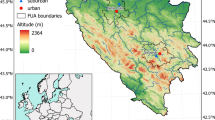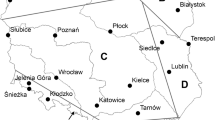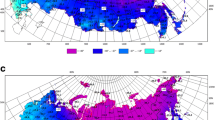Abstract
Long- and short-term biometeorological conditions in the Republic of Serbia were analyzed using official meteorological data from numerous weather stations located across the country. Selected biometeorological indices HUMIDEX, Physiologically Equivalent Temperature (PET), and Universal Thermal Climate Index (UTCI) are calculated based on air temperature, relative humidity, wind speed, and cloudiness data from the meteorological stations on annual and summer level as well as during selected heat wave periods during 2000–2020. Application of different biometeorological indices provides similar but somewhat different results. For example, average annual HUMIDEX and UTCI values indicate no thermal stress and no discomfort at all stations, while PET indicates the occurrence of slight to moderate cold stress at all stations. Average summer PET and UTCI indicate the occurrence of slight to moderate heat stress throughout the country, while HUMIDEX indicates no discomfort. Trends of biometeorological indices on annual and summer level show a general increase throughout the country. Furthermore, heat wave analysis indicated that the most populated cities of Serbia are under dangerous and extreme heat stress during these extreme temperature events, which can influence human health and well-being. The obtained biometeorological information can be used for the preparation of climate adaptation strategies that consider the human biometeorological conditions, with a special focus on developing climate-sensitive and comfortable cities.






Similar content being viewed by others
References
An der Heiden M, Muthers S, Niemann H, Buchholz U, Grabenhenrich L, Matzarakis A (2020) Heat-related mortality: an analysis of the impact of heatwaves in Germany between 1992 and 2017. Dtsch Arztebl Online 117(37):603. https://doi.org/10.3238/arztebl.2020.0603
Anderson V, Leung AC, Mehdipoor H, Jänicke B, Milošević D, Oliveira A, Manavvi S, Kabano P, Dzyuban Y, Aguilar R, Agan PN (2021) Technological opportunities for sensing of the health effects of weather and climate change: a state-of-the-art-review. Int J Biometeorol 65:779–803. https://doi.org/10.1007/s00484-020-02063-z
Arsenović D, Lehnert M, Fiedor D, Šimáček P, Středová H, Středa T, Savić S (2019a) Heat-waves and mortality in Czech cities: a case study for the summers of 2015 and 2016. Geogr Pannonica 23(3):162–172. https://doi.org/10.5937/gp23-22853
Arsenović D, Savić S, Lužanin Z, Radić I, Milošević D, Arsić M (2019b) Heat-related mortality as an indicator of population vulnerability in a mid-sized Central European city (Novi Sad, Serbia, summer 2015). Geogr Pannonica 23(4):204–215. https://doi.org/10.5937/gp23-22680
Basarin B, Kržič A, Lazić L, Lukić T, Đorđević J, Janićijević Petrović B, Ćopić S, Matić D, Hrnjak I, Matzarakis A (2014) Evaluation of bioclimate conditions in two special nature reserves in Vojvodina (Northern Serbia). Carpathian J Earth Environ Sci 9(4):93–108
Basarin B, Lukić T, Mesaroš M, Pavić D, Đorđević J, Matzarakis A (2018) Spatial and temporal analysis of extreme bioclimate conditions in Vojvodina, Northern Serbia. Int J Climatol 38(1):142–157. https://doi.org/10.1002/joc.5166
Basarin B, Lukić T, Matzarakis A (2016) Quantification and assessment of heat and cold waves in Novi Sad, Northern Serbia. Int J Biomet 60(1):139–150.https://doi.org/10.1007/s00484-015-1012-z
Basarin B, Lukić T, Micić Ponjiger T (2021) Detailed analysis of extreme heatwaves in Serbia, South-East Europe. EGU General Assembly Conference Abstracts, pp EGU21–7481
Błażejczyk K, Idzikowska D, Błażejczyk A (2013) Forecast changes for heat and cold stress in Warsaw in the 21st century, and their possible influence on mortality risk. Pap Glob Chang 20:47–62. https://doi.org/10.2478/igbp-2013-0002
Błażejczyk K, Nejedlik P, Skrynyk O, Halaś A, Skrynyk O, Błażejczyk A, Mikulova K (2020) Influence of geographical factors on thermal stress in northern Carpathians. Int J Biomet 65(9):1553–1566. https://doi.org/10.1007/s00484-020-02011-x
Błażejczyk K, Twardosz R, Wałach P, Czarnecka K, Błażejczyk A (2022) Heat strain and mortality effects of prolonged central European heat wave—an example of June 2019 in Poland. Int J Biomet 66(1):149–161. https://doi.org/10.1007/s00484-021-02202-0
Błazejczyk K, Bröde P, Fiala D, Havenith G, Holmér I, Jendritzky G, Kampmann B, Kunert A (2010) Principles of the new Universal Thermal Climate Index (UTCI) and its application to bioclimatic research in European scale. Misc Geogr 14:91–102. https://doi.org/10.2478/mgrsd-2010-0009
Bleta A, Nastos PT, Matzarakis A (2014) Assessment of bioclimatic conditions on Crete Island, Greece. Reg Environ Change 14(5):1967–1981. https://doi.org/10.1007/s10113-013-0530-7
Bröde P, Krüger EL, Rossi FA, Fiala D (2012) Predicting urban outdoor thermal comfort by the Universal Thermal Climate Index UTCI-a case study in Southern Brazil. Int J Biometeorol 56:471–480. https://doi.org/10.1007/s00484-011-0452-3
Dunjić J (2019) Outdoor thermal comfort research in urban areas of Central and Southeast Europe: a review. Geogr Pannonica 23(4):359–373. https://doi.org/10.5937/gp23-24458
Fenner D, Holtmann A, Krug A, Scherer D (2019) Heat waves in Berlin and Potsdam, Germany – long-term trends and comparison of heat wave definitions from 1893 to 2017. Int J Climatol 39(4):2422–2437. https://doi.org/10.1002/joc.5962
Fiala D, Havenith G, Bröde P, Kampmann B, Jendritzky G (2012) UTCI-Fiala multi-node model of human heat transfer and temperature regulation. Int J Biometeorol 56:429–441. https://doi.org/10.1007/s00484-011-0424-7
Fischer EM, Schär C (2010) Consistent geographical patterns of changes in high-impact European heatwaves. Nat Geosci 3(6):398–403. https://doi.org/10.1038/ngeo866
Geletič J, Lehnert M, Savić S, Milošević D (2018) Modelled spatiotemporal variability of outdoor thermal comfort in local climate zones of the city of Brno, Czech Republic. Sci Total Environ 624:385–395. https://doi.org/10.1016/j.scitotenv.2017.12.076
Giannaros C, Agathangelidis I, Papavasileiou G, Galanaki E, Kotroni V, Lagouvardos K, Giannaros TM, Cartalis C, Matzarakis A (2023) The extreme heat wave of July–August 2021 in the Athens urban area (Greece): atmospheric and human-biometeorological analysis exploiting ultra-high resolution numerical modeling and the local climate zone framework. Sci Total Environ 159300. https://doi.org/10.1016/j.scitotenv.2022.159300
Giannopoulou K, Livada I, Santamouris M, Saliari M, Assimakopoulos M, Caouris Y (2014) The influence of air temperature and humidity on human thermal comfort over the greater Athens area. Sustain Cities Soc 10:184–194. https://doi.org/10.1016/j.scs.2013.09.004
Glossary of Terms for Thermal Physiology (2003) J Therm Biol 28:75-106
Golbabaei F, Heidari H, Shamsipour A (2021) The assessment of thermal conditions using humidex in different weather conditions: a case in different climates of Iran. J Health Sci Surveill Syst 9(2):127–134. https://doi.org/10.30476/JHSSS.2021.89141.1158
Hamdi R, Duchêne F, Berckmans J, Delcloo A, Vanpoucke C, Termonia P (2016) Evolution of urban heat wave intensity for the Brussels Capital Region in the ARPEGEClimat A1B scenario. Urban Clim 17:176–195. https://doi.org/10.1016/j.uclim.2016.08.001
Ho HC, Knudby A, Xu Y, Hodul M, Aminipouri M (2016) A comparison of urban heat islands mapped using skin temperature, air temperature, and apparent temperature (HUMIDEX), for the greater Vancouver area. Sci Total Environ 544:929–938. https://doi.org/10.1016/j.scitotenv.2015.12.021
Höppe P (1999) The physiological equivalent temperature–a universal index for the biometeorological assessment of the thermal environment. Int J Biometeorol 43:71–75. https://doi.org/10.1007/s004840050118
Idzikowska D (2010) Differences in bioclimatic conditions in four European cities: Budapest, Paris, Rome and Warsaw. Proceedings of the 7th conference on biometeorology 20:201–206
Ketterer C, Matzarakis A (2014) Human-biometeorological assessment of heat stress reduction by replanning measures in Stuttgart, Germany. Landsc Urban Plan 122:78–88. https://doi.org/10.1016/j.landurbplan.2013.11.003
Lukić M (2019) An analysis of the influence of air temperature and humidity on outdoor thermal comfort in Belgrade (Serbia) using a simple heat index. Arch Techn Sci 21:75–84
Lukić M, Filipović D, Pecelj M, Crnogorac L, Lukić B, Divjak L, Lukić A, Vučićević A (2021) Assessment of outdoor thermal comfort in serbia’s urban environments during different seasons. Atmosphere 12(8):1084. https://doi.org/10.3390/atmos12081084
Lukić M, Pecelj M, Protić B, Filipović D (2019) An evaluation of summer discomfort in Nis (Serbia) using Humidex. Zbornik radova Geografskog instituta" Jovan Cvijić 69(2):109–122. https://doi.org/10.2298/IJGI1902109L
Masterton JM, Richardson FA (1979) Humidex: a method of quantifying human discomfort due to excessive heat and humidity. Environment Canada, Atmospheric Environment
Matzarakis A, Mayer H (1996) Another kind of environmental stress: thermal stress. WHO Newslett 18:7–10
Matzarakis A, Rutz F, Mayer H (2007) Modelling radiation fluxes in simple and complex environments—application of the RayMan model. Int J Biometeorol 51(4):323–334. https://doi.org/10.1007/s00484-006-0061-8
Matzarakis A, Rutz F, Mayer H (2010) Modelling radiation fluxes in simple and complex environments: basics of the RayMan model. Int J Biometeorol 54(2):131–139. https://doi.org/10.1007/s00484-009-0261-0
Meehl GA, Tebaldi C (2004) More intense, more frequent, and longer lasting heat waves in the 21st century. Science 305(5686):994–997. https://doi.org/10.1126/science.1098704
Milosevic D, Dunjić J, Stojanović V (2020a) Investigating micrometeorological differences between saline steppe, forest-steppe and forest environments in northern Serbia during a clear and sunny autumn day. Geogr Pannonica 24(3):176–186. https://doi.org/10.5937/gp24-25885
Milošević D, Savić S, Arsenović D, Lužanin Z, Dunjić J (2020b) Analysis of human thermal comfort in Central European City during summer of 2015: a case of Novi Sad (Serbia). Glasnik SGD 100(1):31–39. https://doi.org/10.2298/GSGD2001031M
Milošević D, Trbić G, Savić S, Popov T, Ivanišević M, Marković M, Ostojić M, Dunjić J, Fekete R, Garić B (2022a) Biometeorological conditions during hot summer days in diverse urban environments of Banja Luka (Bosnia and Herzegovina). Geogr Pannonica 26(1):29–45. https://doi.org/10.5937/gp26-35456
Milošević D, Savić S, Kresoja M, Lužanin Z, Šećerov I, Arsenović D, Dunjić J, Matzarakis A (2022b) Analysis of air temperature dynamics in the “local climate zones” of Novi Sad (Serbia) based on long-term database from an urban meteorological network. Int J Biomet 66(2):371–384. https://doi.org/10.1007/s00484-020-02058-w
Milošević DD, Savić SM, Marković V, Arsenović D, Šećerov I (2016) Outdoor human thermal comfort in local climate zones of Novi Sad (Serbia) during heat wave period. Hungarian Geogr Bull 65(2):129–137. https://doi.org/10.15201/hungeobull.65.2.4
Milošević D, Stojsavljević R, Szabó S, Stankov U, Savić S, Mitrović L (2021) Spatio-temporal variability of precipitation over the Western Balkan countries and its links with the atmospheric circulation patterns. J Geogr Inst “Jovan Cvijić” 71(1):29–42. https://doi.org/10.2298/IJGI2101029M
Pavlović M (2018) Geografija Srbije 1 [Geography of Serbia 1]. University of Belgrade-Faculty of Geography, Belgrade, Serbia
Pecelj M, Matzarakis A, Vujadinović M, Radovanović M, Vagić N, Đurić D, Cvetkovic M (2021a) Temporal analysis of urban-suburban PET, mPET and UTCI indices in Belgrade (Serbia). Atmosphere 12(7):916. https://doi.org/10.3390/atmos12070916
Pecelj M, Błażejczyk A, Vagić N, Ivanović P (2021b) The assessment of human bioclimate of Vranje health resort (Serbia) based on Universal Thermal Climate Index (UTCI) with the focus on extreme biothermal conditions. Geogr Pol 94(2):201–222. https://doi.org/10.7163/GPol.0201
Pecelj M, Pecelj M, Mandić D, Pecelj J, Vujadinović S, Šećerov V, Šabić D, Gajić M, Milinčić M (2010) Bioclimatic assessment of weather condition for recreation in health resorts. In: Mastorakis N, Mladenov V, Demiralp M, Bojkovic Z (eds) Advances in Biology, Bioengineering and Environment, pp 211–214. Retrieved from http://www.wseas.org/multimedia/books/2010/Vouliagmeni/BIOLED.pdf. Accessed 31 Oct 2022
Pecelj M, Djordjević A, Pecelj MR, Pecelj-Purković J, Filipović D, Šećerov V (2017) Biothermal conditions on Mt. Zlatibor based on thermophysiological indices. Arch Biol Sci 69(3):455–461. https://doi.org/10.2298/ABS151223120P
Pecelj MM, Lukić MZ, Filipović DJ, Protić BM, BogdanovićUM (2020) Analysis of the Universal Thermal Climate Index during heat waves in Serbia. Nat Hazards Earth Syst Sci 20:2021–2036.https://doi.org/10.5194/nhess-20-2021-2020
Perkins SE, Alexander LV (2013) On the measurement of heat waves. J Clim 26:4500–4517. https://doi.org/10.1175/JCLI-D-12-00383.1
Potchter O, Cohen P, Lin TP, Matzarakis A (2018) Outdoor human thermal perception in various climates: a comprehensive review of approaches, methods and quantification. Sci Total Environ 631:390–406. https://doi.org/10.1016/j.scitotenv.2018.02.276
Republic Hydrometeorological Service of Serbia (2022) Assessed on 25th October 2022: https://www.hidmet.gov.rs/eng/meteorologija/klimatologija_srbije.php
Rozbicka K, Rozbicki T (2021) Long-term variability of bioclimatic conditions and tourism potential for Warsaw agglomeration (Poland). Int J Biometeorol 65(9):1485–1495. https://doi.org/10.1007/s00484-020-01957-2
Savić S, Selakov A, Milošević D (2014) Cold and warm air temperature spells during the winter and summer seasons and their impact on energy consumption in urban areas. Nat Hazards 73(2):373–387. https://doi.org/10.1007/s11069-014-1074-y
Savić S, Marković V, Šećerov I, Pavić D, Arsenović D, Milošević D, Dolinaj D, Nagy I, Pantelić M (2018) Heat wave risk assessment and mapping in urban areas: case study for a midsized Central European city, Novi Sad (Serbia). Nat Hazards 91(3):891–911. https://doi.org/10.1007/s11069-017-3160-4
Savić S, Arsenović D, Marković V, Milošević D (2019) Temperature risk assessment in urban environments during heat wave periods: a case study on the city of Novi Sad (Serbia). In: Leal Filho W, Trbić G, Filipović D (eds) Climate Change Adaptation in Eastern Europe. Springer, Cham, pp 185–197
Savić S, Trbić G, Milošević D, Dunjić J, Ivanišević M, Marković M (2022) Importance of assessing outdoor thermal comfort and its use in urban adaptation strategies: a case study of Banja Luka (Bosnia and Herzegovina). Theor Appl Climatol 1–17. https://doi.org/10.1007/s00704-022-04237-8
Shevchenko O, Snizhko S, Zapototskyi S, Svintsitska H, Matviienko M, Matzarakis A (2022a) Long-term analysis of thermal comfort conditions during heat waves in Ukraine. Geogr Pol 95(1):53–70. https://doi.org/10.7163/GPol.0226
Shevchenko O, Snizhko S, Zapototskyi S, Matzarakis A (2022b) Biometeorological conditions during the August 2015 mega-heat wave and the summer 2010 mega-heat wave in Ukraine. Atmosphere 13:99. https://doi.org/10.3390/atmos13010099
Statistical Office of the Republic of Serbia (2022) Assessed on 25th October 2022: https://www.stat.gov.rs/en-US
Stojićević G, Basarin B, Lukić T (2016) Detailed bioclimate analysis of Banja Koviljača (Serbia). Geogr Pannonica 20(3):127–135. https://doi.org/10.5937/GeoPan1603127S
Tomczyk AM, Bednorz E, Półrolniczak M, Kolendowicz L (2019) Strong heat and cold waves in Poland in relation with the large-scale atmospheric circulation. Theor Appl Climatol 137(3–4):1909–1923. https://doi.org/10.1007/s00704-018-2715-y
Trbić G, Popov T, Gnjato S (2017) Analysis of air temperature trends in Bosnia and Herzegovina. Geogr Pannonica 21(2):68–84. https://doi.org/10.18421/GP21.02-01
Urban A, Hanzlíková H, Kyselý J, Plavcová E (2017) Impacts of the 2015 heat waves on mortality in the Czech Republic-a comparison with previous heat waves. Int J Environ Res Public Health 14(12):1562. https://doi.org/10.3390/ijerph14121562
Výberči D, Labudová L, Eštóková M, Faško P, Trizna M (2018) Human mortality impacts of the 2015 summerheat spells in Slovakia. Theor Appl Climatol 133:925–936. https://doi.org/10.1007/s00704-017-2224-4
Vysoudil M, Lehnert M, Kladivo P (2016) Heat stress in the urban and suburban landscape and its spatial differentiation through the example of a medium-sized city. Dela 46:163–182. https://doi.org/10.4312/dela.46.163-182
Wibig J (2017) Heat waves in Poland in the period 1951–2015: trends, patterns and driving factors. Meteorol Hydrol Water Manag 6(1):37–45. https://doi.org/10.26491/mhwm/78420
Yu S, Yan Z, Freychet N, Li Z (2020) Trends in summer heatwaves in central Asia from 1917 to 2016: association with large-scale atmospheric circulation patterns. Int J Climatol 40(1):115–127. https://doi.org/10.1002/joc.6197
Funding
Research is funded by the Global Disaster Preparedness Center (GDPC) of the American Red Cross, Red Cross Red Crescent Climate Center and the Global Heat Health Information Network (GHHIN).
Author information
Authors and Affiliations
Corresponding author
Appendix
Appendix
Rights and permissions
Springer Nature or its licensor (e.g. a society or other partner) holds exclusive rights to this article under a publishing agreement with the author(s) or other rightsholder(s); author self-archiving of the accepted manuscript version of this article is solely governed by the terms of such publishing agreement and applicable law.
About this article
Cite this article
Milošević, D., Dunjić, J., Stojsavljević, R. et al. Analysis of long- and short-term biometeorological conditions in the Republic of Serbia. Int J Biometeorol 67, 1105–1123 (2023). https://doi.org/10.1007/s00484-023-02482-8
Received:
Revised:
Accepted:
Published:
Issue Date:
DOI: https://doi.org/10.1007/s00484-023-02482-8




